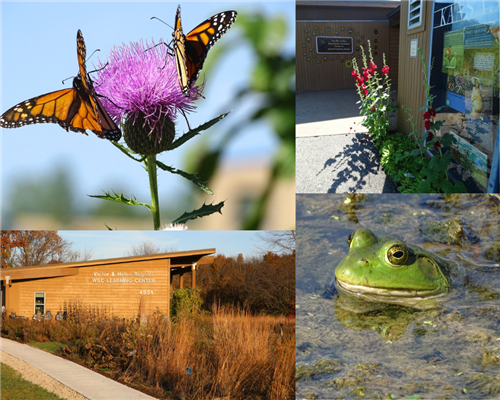Programs
Page Navigation
ABOUT THE WILDERNESS SCIENCE CENTER
-
The Carolyn Ball Blair Wilderness Science Center (WSC) is an educational facility created with the primary goal of providing authentic learning opportunities for students. The trails, study stations and the Helen & Victor Regnier Learning Center on the 30-acre site have been under development since 1999 and are located behind Blue River Elementary and Blue Valley Middle schools.

As our area of the state becomes more populated, there is less land that can truly be considered a natural wildlife area, thus, the importance of the WSC, one of the few remaining areas for students to study natural plant and animal life. The property includes old and new growth forest, prairie, a small wetland, wetland forest, wet meadow, multiple streams and a riparian corridor. Students study four ecosystems at the WSC: prairie, forest, river and wetland.
MISSION
The mission of the Wilderness Science Center is to provide authentic learning experiences that will develop an understanding of and respect for preservation and change, balance in natural systems, history of the land, and the impact of human intervention.

-
RATIONALE
Preservation and change
Nature itself is dynamic, not static. Internal and external natural forces are always at work (wind, water ice, climate variation) changing the land, even as we attempt to preserve it.
Balance in natural systems
The food chain, the interdependence of plants, animals and the land itself, the impact of new species, habitat, niches, extinction are all part of nature's balancing act.
History of the land
We honor the land when we seek to discover its past. The land has a history. Humans and nature have both played a role in shaping that history. Some parts of the land are living history. Some parts are only a memory. Both are important. The more we know about that history, the better we can understand and appreciate what we see in the present.
Impact of human intervention
This land will be impacted by human intervention. Examples might include walking paths; an underground sewer line; introduction of new systems (e.g. a wetlands area, croplands area, tree farm, etc.), feeding stations blinds, fences new plants, visitors. The land may also be impacted by human intervention in areas outside the Environmental Learning Center. We must be able to recognize and understand the effect of these interventions on the natural environment.
-
GUIDELINES
- The WSC facility and grounds are for educational purposes. No camping, fishing, hunting, bicycling or paintball.
- WSC hours are from sunrise to sunset.
- No visitors are allowed during school hours or summer programs.
- Visitors must stay on the paths and trails.
- Visitors must walk, not run.
- The Helen and Victor Regnier Learning Center Building
is not available for reservation by private groups. - Nothing is to be caught, picked, collected or removed from the facility. "Take only photographs, leave only footprints."
- The WSC facility and grounds are for educational purposes. No camping, fishing, hunting, bicycling or paintball.

